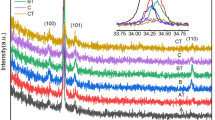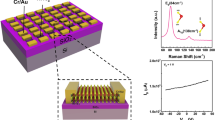Abstract
NbOx thin films have been deposited on silicon (100) and quartz substrates by magnetron sputtering using a metallic Nb target in an optimized argon–oxygen atmosphere. This work investigates the dependence of structure–property relations on the key deposition parameters towards establishing optimum deposition conditions for the growth of NbOx polycrystalline films. It is found that a sputtering condition corresponding to DC power density 9.87 W cm−2, a substrate temperature of 720 °C, low gas pressures of 8 mtorr, a target to substrate distance of 45 mm gives thin films with good homogeneity and a high degree of crystallinity in the case of both NbO2 and Nb2O5. X-ray diffraction (XRD) and Raman spectroscopy confirmed the tetragonal phase of NbO2 and orthorhombic phase of Nb2O5 for similar deposition temperatures. Scanning electron microscopy (SEM) observations indicate that NbO2 has a unique nanoslice structure while Nb2O5 has a flake-like structure. The optical transmittance of the films has been investigated and found to be dependent on the oxygen gas content during deposition; the optical transmittance decreases with increasing O2 gas content. Optical constants of the films were calculated by fitting a suitable thin film transmittance model to experimental transmittance spectra using a modified Swanepoel technique. The nanohardness and stress in the films were measured by nanoindentation and an optical profilometer respectively. Nanohardness and stress in the film show no large dependence on the oxygen gas content except at high oxygen gas content. The nanohardness value of NbO2 films is approximately 6 GPa, and the Young’s modulus is 150 GPa. The Nb2O5 films exhibit a nanohardness of 5.8–13 GPa and a Young’s modulus of 137–161 GPa.










Similar content being viewed by others
References
J.K. Hulm, C.K. Jones, R.A. Hein, J.W. Gibson, Superconductivity in the TiO and NbO systems. J. Low Temp. Phys. 7, 291–307 (1972). https://doi.org/10.1007/BF00660068
R.F. Janninck, D.H. Whitmore, Electrical conductivity and thermoelectric power of niobium dioxide. J. Phys. Chem. Solids 27, 1183–1187 (1966). https://doi.org/10.1016/0022-3697(66)90094-1
C. Funck, S. Menzel, N. Aslam, H. Zhang, A. Hardtdegen, R. Waser, S. Hoffmann-Eifert, Multidimensional simulation of threshold switching in NbO2 based on an electric field triggered thermal runaway model. Adv. Electron. Mater. 2(7), 1600169 (2016). https://doi.org/10.1002/aelm.201600169
Y. Zhao, Z. Zhang, Y. Lin, Optical and dielectric properties of a nanostructured NbO2 thin film prepared by thermal oxidation. J. Phys. D 37, 3392–3395 (2004). https://doi.org/10.1088/0022-3727/37/24/006
Y. Wang, R.B. Comes, S. Kittiwatanakul, S.A. Wolf, J. Lu, Epitaxial niobium dioxide thin films by reactive-biased target ion beam deposition. J. Vac. Sci. Technol. A 33, 021516 (2015). https://doi.org/10.1116/1.4906143
M. Vinnichenko, A. Rogozin, D. Grambole, F. Munnik, A. Kolitsch, W. Möller, O. Stenzel, S. Wilbrandt, A. Chuvilin, U. Kaiser, Highly dense amorphous Nb2O5 films with closed nanosized pores. Appl. Phys. Lett. 95, 081904 (2009). https://doi.org/10.1063/1.3212731
M.A. Aegerter, Sol-gel niobium pentoxide: a promising material for electrochromic coatings, batteries, nanocrystalline solar cells and catalysis. Sol. Energy Mater. Sol. Cells 68(3–4), 401–422 (2001). https://doi.org/10.1016/S0927-0248(00)00372-X
M.F. Pillis, G.A. Geribola, G. Scheidt, E.G. de Araújo, M.C.L. de Oliveira, R.A. Antunes, Corrosion of thin, magnetron sputtered Nb2O5 films. Corros. Sci. 102, 317–325 (2016). https://doi.org/10.1016/j.corsci.2015.10.023
C. Nico, M.R.N. Soares, J. Rodrigues, M. Matos, R. Monteiro, M.P.F. Graça, M.A. Valente, F.M. Costa, T. Monteiro, Sintered NbO powders for electronic device applications. J. Phys. Chem. C 115, 4879–4886 (2011). https://doi.org/10.1021/jp110672u
H. Kupfer, T. Flügel, F. Richter, P. Schlott, Intrinsic stress in dielectric thin films for micromechanical components. Surf. Coatings Technol. 116–119, 116–120 (1999). https://doi.org/10.1016/S0257-8972(99)00114-0
S. Lee, H. Yoon, I. Yoon, B. Kim, Single crystalline NbO2 nanowire synthesis by chemical vapor transport method. Bull. Korean Chem. Soc. 33, 839–842 (2012). https://doi.org/10.5012/Bkcs.2012.33.3.839
M.P.F. Graça, A. Meireles, C. Nico, M.A. Valente, Nb2O5 nanosize powders prepared by sol–gel—structure, morphology and dielectric properties. J. Alloys Compds. 553, 177–182 (2013). https://doi.org/10.1016/j.jallcom.2012.11.128
J.P. Masse, H. Szymanowski, O. Zabeida, A. Amassian, J.E. Klemberg-Sapieha, L. Martinu, Stability and effect of annealing on the optical properties of plasma-deposited Ta2O5 and Nb2O5 films. Thin Solid Films 515, 1674–1682 (2006). https://doi.org/10.1016/j.tsf.2006.05.047
G. Bräuer, B. Szyszka, M. Vergöhl, R. Bandorf, Magnetron sputtering—milestones of 30 years. Vacuum 84(12), 1354–1359 (2010). https://doi.org/10.1016/j.vacuum.2009.12.014
F.J. Wong, N. Hong, S. Ramanathan, Orbital splitting and optical conductivity of the insulating state of NbO2. Phys. Rev. B 90, 1–8 (2014). https://doi.org/10.1103/physrevb.90.115135
C. Nico, T. Monteiro, M.P.F. Graça, Niobium oxides and niobates physical properties: review and prospects. Prog. Mater Sci. 80, 1–37 (2016). https://doi.org/10.1016/j.pmatsci.2016.02.001
M.P.F. Graça, M. Saraiva, F.N.A. Freire, M.A. Valente, L.C. Costa, Electrical analysis of niobium oxide thin films. Thin Solid Films 585, 95–99 (2015). https://doi.org/10.1016/j.tsf.2015.02.047
K. Yoshimura, T. Miki, S. Iwama, S. Tanemura, Characterization of niobium oxide electrochromic thin films prepared by reactive d.c. magnetron sputtering. Thin Solid Films 281–282, 235–238 (1996). https://doi.org/10.1016/0040-6090(96)08640-3
S. Venkataraj, R. Drese, O. Kappertz, R. Jayavel, M. Wuttig, Characterization of niobium oxide films prepared by reactive DC magnetron sputtering. Phys. Status Solidi Appl. Res. 188, 1047–1058 (2001). https://doi.org/10.1002/1521-396X(200112)188:3%3c1047:AID-PSSA1047%3e3.0.CO;2-J
A. Foroughi-Abari, K.C. Cadien, Growth, structure and properties of sputtered niobium oxide thin films. Thin Solid Films 519(10), 3068–3073 (2011). https://doi.org/10.1016/j.tsf.2010.12.036
D.E. Kramer, A.A. Volinsky, N.R. Moody, W.W. Gerberich, Substrate effects on indentation plastic zone development in thin soft films. J. Mater. Res. 16(11), 3150–3157 (2001). https://doi.org/10.1557/JMR.2001.0434
X. Feng, Y. Huang, A.J. Rosakis, On the stoney formula for a thin film/substrate system with nonuniform substrate thickness. J. Appl. Mech. 74(6), 1276–1281 (2007). https://doi.org/10.1115/1.2745392
R. Swanepoel, Determination of the thickness and optical constants of amorphous silicon. J. Phys. E 16(12), 1214–1222 (1983). https://doi.org/10.1088/0022-3735/16/12/023
R. Swanepoel, Determination of surface roughness and optical constants of inhomogeneous amorphous silicon films. J. Phys. E 17(10), 896 (1984). https://doi.org/10.1088/0022-3735/17/10/023
J. Mistrik, S. Kasap, H.E. Ruda, C. Koughia, J. Singh, Optical properties of electronic materials, in Springer Handbook of Electronic and Photonic Materials, 2nd edn., ed. by S. Kasap, P. Capper (Springer, Heidelberg, 2017), pp. 47–83. https://doi.org/10.1007/978-3-319-48933-9. Chapter 3
P. Muhammed Shafi, A. Chandra Bose, Impact of crystalline defects and size on X-ray line broadening. AIP Adv. 5(5), 057137 (2015). https://doi.org/10.1063/1.4921452
G.K. Williamson, W.H. Hall, X-ray line broadening from filed aluminium and wolfram. Acta Metall. 1(1), 22–31 (1953). https://doi.org/10.1016/0001-6160(53)90006-6
S. Kim, J. Park, J. Woo, C. Cho, W. Lee, J. Shin, G. Choi, S. Park, D. Lee, B.H. Lee, H. Hwang, Threshold-switching characteristics of a nanothin-NbO2-layer- based Pt/NbO2/Pt stack for use in cross-point-type resistive memories. Microelectron. Eng. 107, 33–36 (2013). https://doi.org/10.1016/j.mee.2013.02.084
M. Kang, S. Yu, J. Son, Voltage-induced insulator-to-metal transition of hydrogen-treated NbO2 thin films. J. Phys. D 48(9), 095301 (2015). https://doi.org/10.1088/0022-3727/48/9/095301
V.V. Atuchin, I.E. Kalabin, V.G. Kesler, N.V. Pervukhina, Nb 3d and O 1s core levels and chemical bonding in niobates. J. Electron Spectrosc. Relat. Phenom. 142, 129–134 (2005). https://doi.org/10.1016/j.elspec.2004.10.003
D. Music, R.W. Geyer, Theoretical and experimental study of NbO2 nanoslice formation. J. Phys. D 48(30), 305302 (2015). https://doi.org/10.1088/0022-3727/48/30/305302
R. Ghosh, M.K. Brennaman, T. Uher, M.-R. Ok, E.T. Samulski, L.E. McNeil, T.J. Meyer, R. Lopez, Nanoforest Nb2O5 photoanodes for dye-sensitized solar cells by pulsed laser deposition. ACS Appl. Mater. Interfaces 3(10), 3929–3935 (2011). https://doi.org/10.1021/am200805x
S.A. O’Neill, I.P. Parkin, R.J.H. Clark, A. Mills, N. Elliott, Atmospheric pressure chemical vapour deposition of thin films of Nb2O5 on glass. J. Mater. Chem. 13(12), 2952–2956 (2003). https://doi.org/10.1039/B307768n
C.C. Lee, C.L. Tien, J.C. Hsu, Internal stress and optical properties of Nb2O5 thin films deposited by ion-beam sputtering. Appl. Opt. 41(10), 2043–2047 (2002). https://doi.org/10.1364/AO.41.002043
E. Cetinörgü-Goldenberg, J.E. Klemberg-Sapieha, L. Martinu, Effect of postdeposition annealing on the structure, composition, and the mechanical and optical characteristics of niobium and tantalum oxide films. Appl. Opt. 51(27), 6498–6507 (2012). https://doi.org/10.1364/AO.51.006498
W.D. Nix, B.M. Clemens, Crystallite coalescence: a mechanism for intrinsic tensile stresses in thin films. J. Mater. Res. 14(8), 3467–3473 (1999). https://doi.org/10.1557/JMR.1999.0468
S.O. Kasap, W.C. Tan, J. Singh, A.K. Ray, Fundamental optical properties of materials. In J. Singh (ed.) Optical Properties of Condensed Matter and Applications, 2nd edn (Wiley, Chichester, 2019)
W. Sellener, Zur Erkarung der abnormen Farbenfolge im Spectrum einiger. Substanzen. Ann. Phys. Chem. 219, 272–282 (1871). https://doi.org/10.1002/andp.18712190612
G. Mie, Contributions to the optics of turbid media, especially colloidal metal solutions. Ann. Phys. 330(3), 377–445 (1908). https://doi.org/10.1002/andp.19083300302
S.O. Kasap, Optoelectronics and Photonics: Principles & Practices, 2nd edn. (Pearson, Upper Saddle River, 2013)
G. Ramírez, S.E. Rodil, S. Muhl, D. Turcio-Ortega, J.J. Olaya, M. Rivera, E. Camps, L. Escobar-Alarcón, Amorphous niobium oxide thin films. J. Non-Cryst. Solids 356(50–51), 2714–2721 (2010). https://doi.org/10.1016/j.jnoncrysol.2010.09.073
J. Tauc, Optical properties and electronic structure of amorphous Ge and Si. Mater. Res. Bull. 3(1), 37–46 (1968). https://doi.org/10.1016/0025-5408(68)90023-8
A.P. Sokolov, A.P. Shebanin, O.A. Golikova, M.M. Mezdrogina, Structural disorder and optical gap fluctuations in amorphous silicon. J. Phys. 3(49), 9887–9894 (1991). https://doi.org/10.1088/0953-8984/3/49/005
N.F. Mott, E.A. Davis, Electronic processes in non-crystalline materials (Oxford University Press, New York, 1971)
A. O’Hara, T.N. Nunley, A.B. Posadas, S. Zollner, A.A. Demkov, Electronic and optical properties of NbO2. J. Appl. Phys. 116(21), 213705 (2014). https://doi.org/10.1063/1.4903067
Acknowledgements
This project was made possible by a research grant from Cisco Systems and a CRD from NSERC.
Author information
Authors and Affiliations
Corresponding authors
Additional information
Publisher's Note
Springer Nature remains neutral with regard to jurisdictional claims in published maps and institutional affiliations.
Rights and permissions
About this article
Cite this article
Hossain, N., Günes, O., Zhang, C. et al. Structural and physical properties of NbO2 and Nb2O5 thin films prepared by magnetron sputtering. J Mater Sci: Mater Electron 30, 9822–9835 (2019). https://doi.org/10.1007/s10854-019-01319-8
Received:
Accepted:
Published:
Issue Date:
DOI: https://doi.org/10.1007/s10854-019-01319-8




